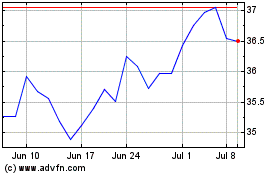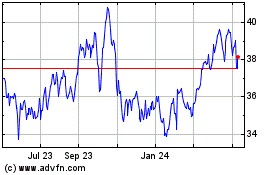BP Results Still Hurt by Gulf of Mexico Spill -- Update
April 26 2016 - 5:13AM
Dow Jones News
By Sarah Kent
LONDON--BP PLC's fatal blowout in the Gulf of Mexico in 2010
continues to haunt the company, helping to drag its quarterly
earnings into a second consecutive loss and overshadowing cost cuts
the British oil giant made to cope with low oil prices.
BP on Tuesday said its replacement-cost loss--a number analogous
to the net income that U.S. oil companies report--was $485 million
for the first quarter of 2016, hurt by weak oil prices and a $917
million pretax charge relating to the Deepwater Horizon explosion
that killed 11 workers and caused a massive spill in the Gulf of
Mexico.
To date, BP has paid $56.4 billion before taxes for charges
relating to the incident at its Macondo oil well. Earlier this
month, a U.S. judge approved a $20 billion settlement of all
federal and state claims arising from the accident, resolving years
of litigation and uncertainty, but also leaving the company with an
annual liability of around $1 billion stretching out over roughly
two decades.
The company still faces additional civil litigation costs
related to the disaster, though the settlement removed significant
uncertainties over the ultimate cost.
The continuing fallout from the massive spill is weighing on the
company during an exceptionally difficult period for the energy
sector. A glut in global crude supply has led to a nearly two-year
slump in prices, dragging down earnings across the industry and
forcing painful spending cuts.
BP suffered its second consecutive quarterly loss in the first
quarter of 2016, as oil prices plummeted to a 13-year low in
January. Throughout the quarter, Brent oil prices averaged $34 a
barrel, compared with $54 a barrel in the same period last year.
Refining margins were at their lowest quarterly average for over
five years.
However, the company's underlying earnings--which strip out
one-time items like impairment charges--were resilient, helped by
efforts to bring down costs. BP reported underlying profit of $532
million for the first quarter, significantly beating analysts'
consensus forecast for a loss of $140 million.
The underlying profit was strong despite a precipitous drop in
revenue, which fell to $39.2 billion in the first three months of
2016, from $56.2 billion during the same period of 2015.
BP said it now expects its capital expenditure to total around
$17 billion this year, the lower end of its previous guidance. By
next year it expects its cash costs to be $7 billion lower than in
2014, allowing the company to balance its spending and cash flow at
oil prices of $50 to $55 a barrel.
"Despite the challenging environment, we are driving toward our
near-term goal of rebalancing BP's cash flows," Chief Executive Bob
Dudley said. "Operational performance is strong and our work to
reset costs has considerable momentum and is delivering
results."
BP's stock was up 3.2% in early trading in London following the
results.
BP's "progress on cost reductions is apparent in the results,"
said Jason Gammel, a European oil analyst with the investment bank
Jefferies, though he said in a note that the company's cash flow
was lower than expected.
Corrections & Amplifications
Brent oil prices in the first quarter of 2016 averaged $34 a
barrel. An earlier version of this article incorrectly stated the
time period as the first quarter of 2015. (April 26, 2016)
Write to Sarah Kent at sarah.kent@wsj.com
(END) Dow Jones Newswires
April 26, 2016 04:58 ET (08:58 GMT)
Copyright (c) 2016 Dow Jones & Company, Inc.
BP (NYSE:BP)
Historical Stock Chart
From Mar 2024 to Apr 2024

BP (NYSE:BP)
Historical Stock Chart
From Apr 2023 to Apr 2024
